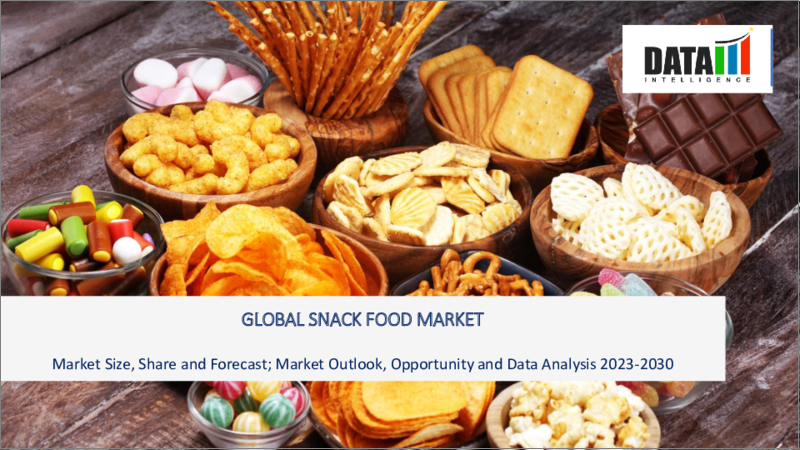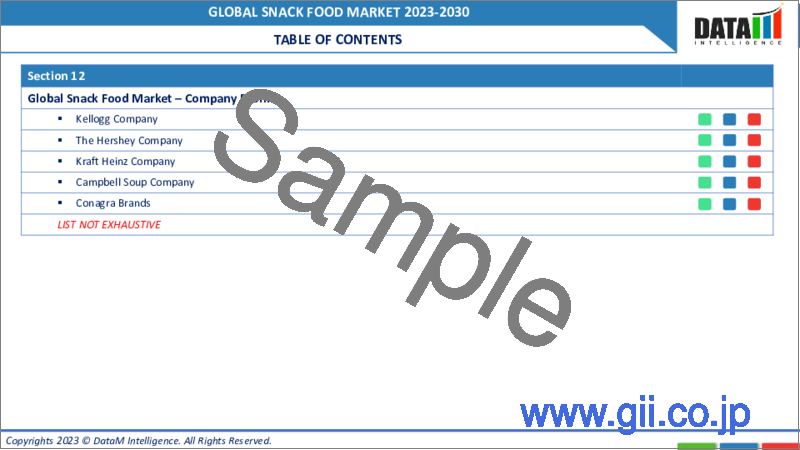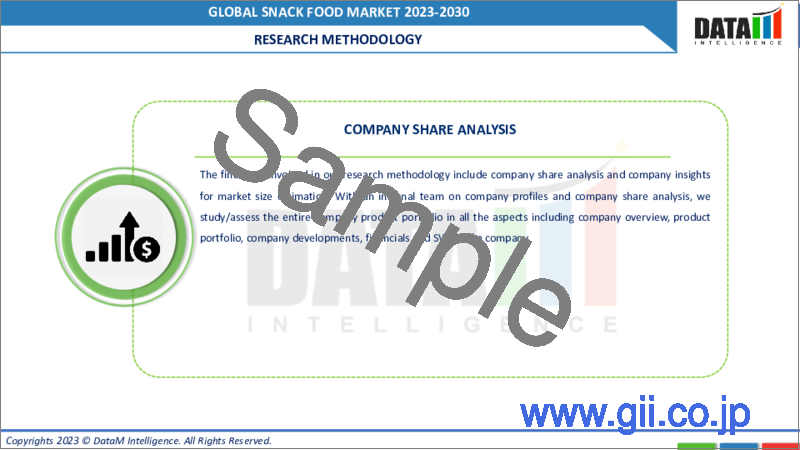|
|
市場調査レポート
商品コード
1304472
スナック食品の世界市場-2023年~2030年Global Snack Food Market - 2023-2030 |
||||||
カスタマイズ可能
適宜更新あり
|
|||||||
| スナック食品の世界市場-2023年~2030年 |
|
出版日: 2023年07月07日
発行: DataM Intelligence
ページ情報: 英文 190 Pages
納期: 即日から翌営業日
|
- 全表示
- 概要
- 目次
市場概要
スナック食品の世界市場は、2022年に4億8,540万米ドルに達し、2030年には6億5,920万米ドルに達すると予測され、予測期間2023-2030年のCAGRは3.9%で成長する見込みです。スナック食品市場の有力な動向の1つは、基本的な栄養だけでなくその他の健康特典を提供する機能性スナックの急増です。この動向は、プロテイン・バーやプロテイン・チップスのようなタンパク質入りのスナックの台頭であり、毎日のタンパク質摂取を満たす便利で満足感のある方法を提供します。
スナック食品市場は、進化する消費者の嗜好とライフスタイルに後押しされ、ダイナミックに繁栄する業界です。利便性、健康、嗜好性への注目が高まる中、同市場は多様な嗜好に対応するため、幅広いスナックの選択肢を提供しています。スナック食品の売上は、多忙なスケジュール、外出先での消費、手軽で満足感のあるスナック食品への欲求といった要因に後押しされ、世界的に成長を続けています。
利便性がスナック食品市場を牽引しています。市場分析によると、消費者の92%がスナック食品を選ぶ際に利便性を重要視しています。そのため、忙しく外出の多いライフスタイルのニーズに対応するため、持ち運びが容易なスナック食品、1回分ずつ包装されたスナック食品、持ち運び可能なスナック食品などが台頭しています。
市場力学
RTEスナック、多様なセイボリーとスイーツのオプションに対する需要の高まりが市場の成長を牽引
スナック食品市場の動向を牽引しているのは、利便性が高く、食欲を満たすRTEスナック食品への需要の高まりです。包装済みのチップス、クッキー、バーなど、RTEスナックは忙しいライフスタイルや外出先での消費に対応します。さらに、チップス、ポップコーン、プレッツェルなど、満足感のある香ばしい風味を楽しめるスナックの人気も市場を後押ししています。
また、チョコレート、キャンディー、ペストリーなどの甘いスナックも、消費者の甘いもの好きを満足させる嗜好品として、市場成長を牽引する重要な役割を担っています。こうした促進要因が、スナック食品市場の継続的な拡大と多様化に寄与しています。
ヘルシー・スナック、利便性、持続可能な包装への消費者の関心のシフトが市場成長を牽引
スナック食品市場では、消費者の嗜好がより健康的なスナック食品へとシフトしています。おいしいだけでなく、栄養価が高く、健康全般を促進するスナック食品への需要が高まっています。消費者の健康志向の高まりに伴い、オーガニック、ナチュラル、低糖質などのヘルシーなスナックが人気を集めています。
多忙なライフスタイルや外出先での消費習慣により、食べやすく持ち運びやすいスナック・オプションのニーズが高まっているため、利便性も促進要因のひとつとなっています。さらに、持続可能なパッケージングに対する認識と関心が高まっており、環境への影響を減らすために環境にやさしくリサイクル可能なパッケージング・ソリューションを採用するよう市場に促しています。
スナック食品市場は、スナック食品のフレーバー、原材料、製造プロセスに対する消費者の期待に応える上で課題に直面しています
スナック食品市場の主な抑制要因の1つは、多様なスナック食品のフレーバーや品種、スナック食品の原材料、スナック食品の製造プロセスに対する需要のバランスを取るという課題にあります。消費者が幅広い選択肢を切望する一方で、こうした需要に応えることはメーカーにとって課題となっています。新しいフレーバーや品種の開発・導入には研究開発に多額の投資が必要であり、消費者に受け入れられるかどうかという潜在的なリスクも伴う。
同様に、高品質のスナック原材料を調達し、十分な量を確保することも制約となり得ます。さらに、品質、効率、費用対効果を維持するためにスナック食品の製造工程を最適化することは、さらなるハードルとなります。こうした制約を克服し、消費者に望ましいスナック体験を提供するためには、継続的なイノベーション、サプライチェーン管理、卓越したオペレーションが必要です。
COVID-19影響分析
COVID-19分析には、COVID前シナリオ、COVIDシナリオ、COVID後シナリオに加え、価格力学(COVID前シナリオと比較したパンデミック中およびパンデミック後の価格変動を含む)、需給スペクトラム(取引制限、封鎖、およびその後の問題による需給の変化)、政府の取り組み(政府機関による市場、セクター、業界を活性化させる取り組み)、メーカーの戦略的取り組み(COVID問題を緩和するためにメーカーが行った取り組み)が含まれます。
目次
第1章 調査手法と調査範囲
第2章 市場の定義と概要
第3章 エグゼクティブサマリー
第4章 市場力学
- 市場への影響要因
- 促進要因
- 抑制要因
- 機会
- 影響分析
第5章 産業分析
- ポーターのファイブフォース分析
- サプライチェーン分析
- 価格分析
- 規制分析
第6章 COVID-19分析
第7章 タイプ別
- ベーカリースナック
- 菓子類
- 塩味スナック
- スペシャルティ&冷凍スナック
第8章 流通チャネル別
- スーパーマーケット/ハイパーマーケット
- コンビニエンスストア
- オンラインストア
- その他
第9章 地域別
- 北米
- 米国
- カナダ
- メキシコ
- 欧州
- ドイツ
- 英国
- フランス
- イタリア
- スペイン
- その他欧州
- 南米
- ブラジル
- アルゼンチン
- その他南米
- アジア太平洋
- 中国
- インド
- 日本
- オーストラリア
- その他アジア太平洋地域
- 中東・アフリカ
第10章 競合情勢
- 競合シナリオ
- 市況/シェア分析
- M&A分析
第11章 企業プロファイル
- PepsiCo
- 会社概要
- 製品ポートフォリオと説明
- 財務概要
- 主な発展
- Nestle
- General Mills
- Mondelez International
- Mars, Incorporated
- Kellogg Company
- The Hershey Company
- Kraft Heinz Company
- Campbell Soup Company
- Conagra Brands
第12章 付録
Market Overview
The Global Snack Food Market reached US$ 485.4 million in 2022 and is expected to reach US$ 659.2 million by 2030 and is expected to grow with a CAGR of 3.9% during the forecast period 2023-2030. One prevailing trend in the snack food market is the surge of functional snacks that offer additional health benefits beyond basic nutrition. This trend is the rise of protein-packed snacks like protein bars and protein chips, which provide a convenient and satisfying way to meet daily protein intake.
The snack food market is a dynamic and thriving industry, driven by evolving consumer preferences and lifestyles. With an increasing focus on convenience, health, and indulgence, the market offers a wide array of snack options, to cater to diverse tastes. Snack food sales continue to grow globally, fueled by factors such as busy schedules, on-the-go consumption, and the desire for quick and satisfying snack solutions.
The convenience factor is a driving force in the snack food market. According to the market analysis, 92% of consumers consider convenience an important factor when choosing snacks. This has led to the rise of grab-and-go snack options, single-serve packaging, and portable snack formats to cater to the needs of busy, on-the-go lifestyles.
Market Dynamics
Growing Demand for Ready-to-Eat Snacks and Diverse Savory and Sweet Options is Driving the Growth of the Market
The snack food market trend is driven by the increasing demand for ready-to-eat snacks that offer convenience and satisfy cravings. Ready-to-eat snacks, such as pre-packaged chips, cookies, and bars, cater to busy lifestyles and on-the-go consumption. Additionally, the market is fueled by the popularity of savory snacks, including chips, popcorn, and pretzels, which provide a satisfying and savory flavor experience.
Sweet snacks, such as chocolates, candies, and pastries, also play a significant role in driving market growth, offering indulgence and gratifying consumers' sweet tooth. These drivers contribute to the continuous expansion and diversification of the snack food market.
Shifting Consumer Focus toward Healthy Snacks, Convenience, and Sustainable Packaging Driving the Market Growth
The snack food market is experiencing a shift in consumer preferences toward healthier snack options. There is a growing demand for snacks that are not only tasty but also offer nutritional value and promote overall well-being. Healthy snacks, including organic, natural, and low-sugar alternatives, are gaining popularity as consumers become more health-conscious.
Convenience is another driver, as busy lifestyles and on-the-go consumption habits drive the need for easy-to-eat and portable snack options. Furthermore, there is increasing awareness and concern about sustainable packaging, prompting the market to adopt eco-friendly and recyclable packaging solutions to reduce environmental impact.
The Snack Food Market Facing Challenges in Meeting Consumer Expectations for Snack Flavors, Ingredients, and Manufacturing Processes
One key restraint of the snack market lies in the challenge of balancing the demand for diverse snack flavors and varieties, snack ingredients, and snack manufacturing processes. While consumers crave a wide range of options, meeting these demands poses challenges for manufacturers. Developing and introducing new flavors and varieties requires significant investment in research and development, as well as potential risks associated with consumer acceptance.
Similarly, sourcing high-quality snack ingredients and ensuring their availability in sufficient quantities can be a constraint. Moreover, optimizing snack manufacturing processes to maintain quality, efficiency, and cost-effectiveness presents additional hurdles. Overcoming these restraints requires continuous innovation, supply chain management, and operational excellence to deliver the desired snack experience to consumers.
COVID-19 Impact Analysis
The COVID-19 Analysis includes Pre-COVID Scenario, COVID Scenario and Post-COVID Scenario along with Pricing Dynamics (Including pricing change during and post-pandemic comparing it with pre-COVID scenarios), Demand-Supply Spectrum (Shift in demand and supply owing to trading restrictions, lockdown and subsequent issues), Government Initiatives (Initiatives to revive market, sector or Industry by Government Bodies) and Manufacturers Strategic Initiatives (What manufacturers did to mitigate the COVID issues will be covered here).
Segment Analysis
The global Snack Food market has been segmented by type, distribution channel, and region.
Traditional Retail And Online Channels Dominate Snack Food Market Distribution
Approximately 40% of snack food sales in the market are distributed through traditional retail channels, such as supermarkets, hypermarkets, and convenience stores. Online channels, including e-commerce platforms, contribute to around 30% of the distribution, experiencing significant growth in recent years. Foodservice channels, such as restaurants, cafes, and food stalls, account for approximately 15% of the market share.
Direct-to-consumer models, including subscription services and meal kit delivery, make up around 5% of snack food distribution. Specialty stores, such as gourmet shops and health food stores, contribute to about 5% of the market. Finally, vending machines and other automated retail channels hold a share of roughly 3%. Please note that these figures are approximate and can vary depending on the region and market conditions.
Geographical Analysis
Expansive Opportunities and Growing Demand Drive Asia Pacific Snack Food Market
By region, the global snack food market is segmented into North America, South America, Europe, Asia-Pacific, Middle-east, and Africa.
The Asia Pacific snack food market is regarded as fastest growing region in the global snack food industry. The snack food market size is estimated to be in the range of billions of dollars, it presents a lucrative opportunity for snack food manufacturers. The market is witnessing a growing preference for better-for-you snacks, including organic, low-sugar, and functional options, which account for around 20-25% of the overall snack food market share.
Online retail channels, such as e-commerce platforms, contribute approximately 15-20% of total snack food sales in the Asia Pacific region, reflecting the increasing influence of digital platforms. Notably, countries like China, India, and Japan play a pivotal role, collectively contributing to around 50-60% of the snack food market share. These statistics highlight the region's dominance in the snack food industry and the emerging trends that shape consumer choices in the market.
Competitive Landscape
The major global players in the market include: PepsiCo, Nestle, General Mills Inc, Mondelez International, Mars, Incorporated, Kellogg Company, The Hershey Company, Kraft Heinz Company, Campbell Soup Company, and Conagra Brands.
Why Purchase the Report?
- To visualize the global snack food market segmentation based on type, distribution channel, and region, as well as understand key commercial assets and players.
- Identify commercial opportunities in the market by analyzing trends and co-development.
- Excel data sheet with numerous data points of Snack Food market-level with all segments.
- The PDF report consists of a cogently put-together market analysis after exhaustive qualitative interviews and an in-depth market study.
- Product mapping is available as Excel consists of key products of all the major market players.
The global snack food market report would provide approximately 53 tables, 49 figures, and 190 pages.
Target Audience 2023
- Manufacturers/ Buyers
- Industry Investors/Investment Bankers
- Research Professionals
- Emerging Companies
Table of Contents
1. Methodology and Scope
- 1.1. Research Methodology
- 1.2. Research Objective and Scope of the Report
2. Market Definition and Overview
3. Executive Summary
- 3.1. Market Snippet, by Type
- 3.2. Market Snippet, by Distribution Channel
- 3.3. Market Snippet, by Region
4. Market Dynamics
- 4.1. Market Impacting Factors
- 4.1.1. Drivers
- 4.1.2. Restraints
- 4.1.3. Opportunity
- 4.1.4. Impact Analysis
5. Industry Analysis
- 5.1. Porter's Five Force Analysis
- 5.2. Supply Chain Analysis
- 5.3. Pricing Analysis
- 5.4. Regulatory Analysis
6. COVID-19 Analysis
- 6.1. Analysis of COVID-19 on the Market
- 6.1.1. Scenario Before COVID-19
- 6.1.2. Scenario During COVID-19
- 6.1.3. Scenario Post COVID-19
- 6.2. Pricing Dynamics Amid COVID-19
- 6.3. Demand-Supply Spectrum
- 6.4. Government Initiatives Related to the Market During the Pandemic
- 6.5. Manufacturer's Strategic Initiatives
- 6.6. Conclusion
7. By Type
- 7.1. Introduction
- 7.1.1. Market Size Analysis and Y-o-Y Growth Analysis (%), By Type
- 7.1.2. Market Attractiveness Index, By Type
- 7.2. Bakery Snacks *
- 7.2.1. Introduction
- 7.2.2. Market Size Analysis and Y-o-Y Growth Analysis (%)
- 7.3. Confectionery
- 7.4. Salted Snacks
- 7.5. Specialty & Frozen Snacks
8. By Distribution Channel
- 8.1. Introduction
- 8.1.1. Market Size Analysis and Y-o-Y Growth Analysis (%), By Distribution Channel
- 8.1.2. Market Attractiveness Index, By Distribution Channel
- 8.2. Supermarkets/Hypermarkets*
- 8.2.1. Introduction
- 8.2.2. Market Size Analysis and Y-o-Y Growth Analysis (%)
- 8.3. Convenience Stores
- 8.4. Online Stores
- 8.5. Others
9. By Region
- 9.1. Introduction
- 9.1.1. Market Size Analysis and Y-o-Y Growth Analysis (%), By Region
- 9.1.2. Market Attractiveness Index, By Region
- 9.2. North America*
- 9.2.1. Introduction
- 9.2.2. Key Region-Specific Dynamics
- 9.2.3. Market Size Analysis and Y-o-Y Growth Analysis (%), By Type
- 9.2.4. Market Size Analysis and Y-o-Y Growth Analysis (%), By Distribution Channel
- 9.2.5. Market Size Analysis and Y-o-Y Growth Analysis (%), By Country
- 9.2.5.1. The U.S.
- 9.2.5.2. Canada
- 9.2.5.3. Mexico
- 9.3. Europe
- 9.3.1. Introduction
- 9.3.2. Key Region-Specific Dynamics
- 9.3.3. Market Size Analysis and Y-o-Y Growth Analysis (%), By Type
- 9.3.4. Market Size Analysis and Y-o-Y Growth Analysis (%), By Distribution Channel
- 9.3.5. Market Size Analysis and Y-o-Y Growth Analysis (%), By Country
- 9.3.5.1. Germany
- 9.3.5.2. The U.K.
- 9.3.5.3. France
- 9.3.5.4. Italy
- 9.3.5.5. Spain
- 9.3.5.6. Rest of Europe
- 9.4. South America
- 9.4.1. Introduction
- 9.4.2. Key Region-Specific Dynamics
- 9.4.3. Market Size Analysis and Y-o-Y Growth Analysis (%), By Type
- 9.4.4. Market Size Analysis and Y-o-Y Growth Analysis (%), By Distribution Channel
- 9.4.5. Market Size Analysis and Y-o-Y Growth Analysis (%), By Country
- 9.4.5.1. Brazil
- 9.4.5.2. Argentina
- 9.4.5.3. Rest of South America
- 9.5. Asia-Pacific
- 9.5.1. Introduction
- 9.5.2. Key Region-Specific Dynamics
- 9.5.3. Market Size Analysis and Y-o-Y Growth Analysis (%), By Type
- 9.5.4. Market Size Analysis and Y-o-Y Growth Analysis (%), By Distribution Channel
- 9.5.5. Market Size Analysis and Y-o-Y Growth Analysis (%), By Country
- 9.5.5.1. China
- 9.5.5.2. India
- 9.5.5.3. Japan
- 9.5.5.4. Australia
- 9.5.5.5. Rest of Asia-Pacific
- 9.6. Middle East and Africa
- 9.6.1. Introduction
- 9.6.2. Key Region-Specific Dynamics
- 9.6.3. Market Size Analysis and Y-o-Y Growth Analysis (%), By Type
- 9.6.4. Market Size Analysis and Y-o-Y Growth Analysis (%), By Distribution Channel
10. Competitive Landscape
- 10.1. Competitive Scenario
- 10.2. Market Positioning/Share Analysis
- 10.3. Mergers and Acquisitions Analysis
11. Company Profiles
- 11.1. PepsiCo
- 11.1.1. Company Overview
- 11.1.2. Product Portfolio and Description
- 11.1.3. Financial Overview
- 11.1.4. Key Developments
- 11.2. Nestle
- 11.3. General Mills
- 11.4. Mondelez International
- 11.5. Mars, Incorporated
- 11.6. Kellogg Company
- 11.7. The Hershey Company
- 11.8. Kraft Heinz Company
- 11.9. Campbell Soup Company
- 11.10. Conagra Brands
LIST NOT EXHAUSTIVE
12. Appendix
- 12.1. About Us and Services
- 12.2. Contact Us





